| Pages:
1
2 |
Lion850
National Hazard
   
Posts: 517
Registered: 7-10-2019
Location: Australia
Member Is Offline
Mood: Great
|
|
Batch test:
30g NaOH was dissolved in 100g water and 75g b-alanine was then added. This quickly dissolved complete giving a clear solution which was then made up
to 200g by adding a bit more water. Assuming the product of the reaction is C3H6NO2Na then the alanine was in slight access and I should have ended up
with 8g sodium-alanine in every 20g of solution.
20g portions of this solution was then mixed with solution containing about 5g of each of the below salts to see what happens and if anything produces
a salt interesting enough to extract.
1) Cobalt ii nitrate - a pink-ish ppt was formed.
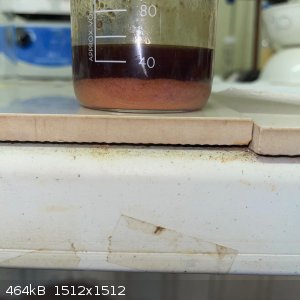
2) Copper sulphate - a very dark blue fine suspension, similar to the first post above.

3) Erbium iii bromide - a pale pink jelly ppt.

4) Iron iii nitrate - a brown ppt.
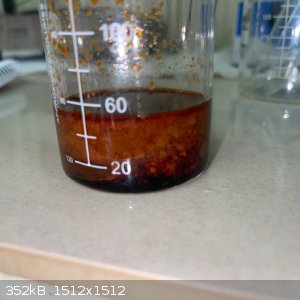
5) Iron ii sulphate - a grey ppt.

6) Manganese ii nitrate - a very pale pink ppt.

7) Nickel ii nitrate yielded a copious amount of a lovely blue ppt. I filtered this off and rinsed it with water.

The color paled a bit after it dried on the bench:

8) Praseodymium iii nitrate gave a green jelly.
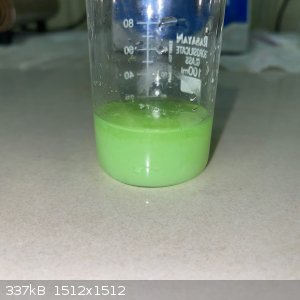
9) Titanium iii chloride was interesting: Once mixed the solution started to bubble. The gas produced had no smell. It also heated up slightly.
Eventually there was a white-ish suspension left which I assume is TiO2?
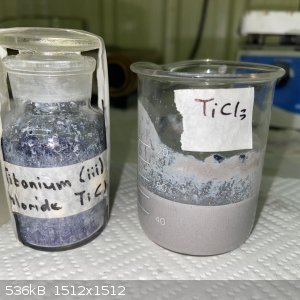
|
|
|
Bezaleel
Hazard to Others
  
Posts: 444
Registered: 28-2-2009
Member Is Offline
Mood: transitional
|
|
The black and red-purple chromium salts are really special. I would expect them to have Cr and b-alanine in different proportions. Did you do any
tests on those compounds? It's a pity that S.C. Wack's excerpt from Gmelin's doesn't seem to mention anything about the colours of the complexes.
The blue nickel salt is gorgeous! Quite special to see nickel adopt a type of blue like that. I made nickel citrate last week, but the colour is a
regular bluish green, like we know from other nickel compounds. It became a syrup which slowly dried up to a hard layer.
Besides, you would really do me a favour if you would rotate the pictures so that the beakers do not show horizontally. To me it makes looking at
those pictures so much easier. Having said that, I always enjoy reading your posts.
|
|
|
S.C. Wack
bibliomaster
    
Posts: 2419
Registered: 7-5-2004
Location: Cornworld, Central USA
Member Is Offline
Mood: Enhanced
|
|
Except where it says red, violet, dark green, and green...BTW that was from part C, presumably also where the relevant section on Cu would be if it
was one of the 183 volumes scanned by Springer...sale ends tomorrow on 719 volumes, $4 shipping.
|
|
|
DraconicAcid
International Hazard
    
Posts: 4355
Registered: 1-2-2013
Location: The tiniest college campus ever....
Member Is Offline
Mood: Semi-victorious.
|
|
Nickel is usually blue when it has both N-bound and O-bound ligands in an octahedral arrangement (if it just has O-bound ligands, then it's almost
always green, and if it just has N-bound ligands then it's generally purple). Tris(glycinato)nickel is that kind of blue, although I've never been
able to get it out of solution.
The chromium complex(es) may be complicated. Chromium(III) isn't labile, so you're likely to have different isomers even assuming you have the same
Cr-alanine ratio. Cis, trans, fac, mer.....lots of fun.
Please remember: "Filtrate" is not a verb.
Write up your lab reports the way your instructor wants them, not the way your ex-instructor wants them.
|
|
|
Lion850
National Hazard
   
Posts: 517
Registered: 7-10-2019
Location: Australia
Member Is Offline
Mood: Great
|
|
Hi DraconicAcid I now hold the phone sideways and select ‘square’ seemed to have worked with the last post. The only things I can say about the
chromium b alanine is that it is very soluble in water, reasonably soluble in methanol and easily makes a sticky mess if chromium acetate is involved
as a starting material. Also was more white after the steam bath but then returned to violet standing on the bench overnight.
I would like to do chromium again starting from chromium carbonate - I tried to make some but it was a mess of jelly.
|
|
|
Bezaleel
Hazard to Others
  
Posts: 444
Registered: 28-2-2009
Member Is Offline
Mood: transitional
|
|
Quote: Originally posted by S.C. Wack  |
Except where it says red, violet, dark green, and green...BTW that was from part C, presumably also where the relevant section on Cu would be if it
was one of the 183 volumes scanned by Springer...sale ends tomorrow on 719 volumes, $4 shipping. |
"Das nach Eindampfen auf dem Wasserbad erhaltene glasartige rote Rk.-Prod."
"Der gebildete, violette kristalline Nd."
I must have been really tired....
Quote: Originally posted by DraconicAcid  | | Nickel is usually blue when it has both N-bound and O-bound ligands in an octahedral arrangement (if it just has O-bound ligands, then it's almost
always green, and if it just has N-bound ligands then it's generally purple). Tris(glycinato)nickel is that kind of blue, although I've never been
able to get it out of solution. |
Thanks for that piece of insight 
Quote: Originally posted by Lion850  | | Hi DraconicAcid I now hold the phone sideways and select ‘square’ seemed to have worked with the last post. |
Great!
Quote: Originally posted by Lion850  | | The only things I can say about the chromium b alanine is that it is very soluble in water, reasonably soluble in methanol and easily makes a sticky
mess if chromium acetate is involved as a starting material. |
I got a sticky foaming mess dissolving SrCO3
in dilute acetic acid. It could be that acetate tends to make the liquid viscous.
Quote: Originally posted by Lion850  | | I would like to do chromium again starting from chromium carbonate - I tried to make some but it was a mess of jelly. |
I made Cr-carbonate a few years back and it formed a very voluminous precipitate. Suction filtration and washing took al long time.
It was not sticky, just voluminous, but I made it from the chloride, not the acetate.
|
|
|
vano
National Hazard
   
Posts: 661
Registered: 22-3-2019
Location: Georgia
Member Is Offline
|
|
Quote: Originally posted by Lion850  | .
9) Titanium iii chloride was interesting: Once mixed the solution started to bubble. The gas produced had no smell. It also heated up slightly.
Eventually there was a white-ish suspension left which I assume is TiO2?
|
I do not know why but I do not have titanium compounds. Will you make other titanium compounds in the future? For example Cobalt (II) orthotitanate.
It has beautiful dark green colour, aslo there are many beautiful compounds which you will like. I hope i try in the future
|
|
|
Bedlasky
International Hazard
    
Posts: 1241
Registered: 15-4-2019
Location: Period 5, group 6
Member Is Offline
Mood: Volatile
|
|
Lion850: TiCl3 is quite unstable, you must store it under inert atmosphere. Gas evolving from solution is hydrogen. You must dissolve it in HCl and
not in water, because in water Ti(OH)3 is formed and this compound is very unstable and decompose in very very short time.
Btw. it is better to make fresh TiCl3 solution before using than making and storing solid.
|
|
|
vano
National Hazard
   
Posts: 661
Registered: 22-3-2019
Location: Georgia
Member Is Offline
|
|
I agree with Bedlasky. No problem if it from chemical company, but i think Homemade will be contaminated. This is easy to identify, just the color
will not be appropriate.
[Edited on 8-3-2021 by vano]
|
|
|
Bezaleel
Hazard to Others
  
Posts: 444
Registered: 28-2-2009
Member Is Offline
Mood: transitional
|
|
Quote: Originally posted by Bedlasky  | Lion850: TiCl3 is quite unstable, you must store it under inert atmosphere. Gas evolving from solution is hydrogen. You must dissolve it in HCl and
not in water, because in water Ti(OH)3 is formed and this compound is very unstable and decompose in very very short time.
Btw. it is better to make fresh TiCl3 solution before using than making and storing solid. |
But how do you do that? Ti dissolves extremely slowly in whatever concentration of HCl you use.
|
|
|
vano
National Hazard
   
Posts: 661
Registered: 22-3-2019
Location: Georgia
Member Is Offline
|
|
The best way to dissolve titanium is hydrofluoric acid. I think he used titanium dioxide. It dissolves in concentrated hot hydrochloric acid at 90°C,
but I'm sure the product will not be pure.
|
|
|
Bedlasky
International Hazard
    
Posts: 1241
Registered: 15-4-2019
Location: Period 5, group 6
Member Is Offline
Mood: Volatile
|
|
I use titanium powder which dissolves quite well in concentrated hydrochloric acid. I don't need it often, so I bought just the smallest 100g bottle
for 5,75€. I know that you can buy titanium cheaper, but if you work in small scale, it is better to invest in to powder, you save yourself lots of
time with disolution.
Quote: Originally posted by vano  |
The best way to dissolve titanium is hydrofluoric acid. I think he used titanium dioxide. It dissolves in concentrated hot hydrochloric acid at 90°C,
but I'm sure the product will not be pure. |
You need strong reducing agent for reduction Ti(IV) to Ti(III), HCl is just weak reductor.
[Edited on 8-3-2021 by Bedlasky]
|
|
|
Lion850
National Hazard
   
Posts: 517
Registered: 7-10-2019
Location: Australia
Member Is Offline
Mood: Great
|
|
Quote: Originally posted by vano  |
I think he used titanium dioxide. It dissolves in concentrated hot hydrochloric acid at 90°C, but I'm sure the product will not be pure.
|
Vano my report on making TiCl3 is here:
http://www.sciencemadness.org/talk/viewthread.php?tid=12981&...
As stated in the report i used titanium powder and it dissolved in HCl without too much difficulty. But for sure the end product is not pure. And it
has now been sitting in the bottle for nearly a year.
|
|
|
vano
National Hazard
   
Posts: 661
Registered: 22-3-2019
Location: Georgia
Member Is Offline
|
|
Lion850: nice, thanks.
Bedlasky: I do not know why I made this simple mistake. Of course you are right.
|
|
|
Lion850
National Hazard
   
Posts: 517
Registered: 7-10-2019
Location: Australia
Member Is Offline
Mood: Great
|
|
The erbium b-alanine salt mention in the batch test post above was filtered off and washed in the funnel and dried on the steam bath. I half expected
the colour to fade during drying but they retained the pink nicely.
 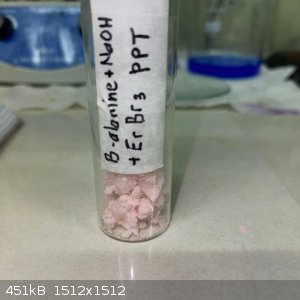
|
|
|
Lion850
National Hazard
   
Posts: 517
Registered: 7-10-2019
Location: Australia
Member Is Offline
Mood: Great
|
|
Hi Vano - how did you go with the taurine?
|
|
|
Dmishin
Harmless

Posts: 32
Registered: 5-10-2015
Member Is Offline
Mood: No Mood
|
|
Just want to revive this topic and show my humble finds.
First photo is a crystal of copper beta-alaninate. It is apparently a hydrate, exposed to air, it dehydrates rather quickly.
Second and third show crystals of cpper beta-alaninate urea adduct. Obtained by crystallizing a solution, containing copper beta-alaninate and urea in
1:2 molar ratio.
Crystals have different form and do not dehydrate in dry air!
  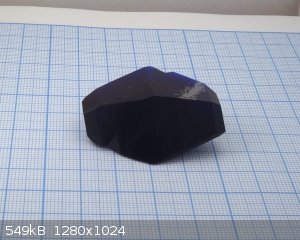
|
|
|
DraconicAcid
International Hazard
    
Posts: 4355
Registered: 1-2-2013
Location: The tiniest college campus ever....
Member Is Offline
Mood: Semi-victorious.
|
|
Wow!
Please remember: "Filtrate" is not a verb.
Write up your lab reports the way your instructor wants them, not the way your ex-instructor wants them.
|
|
|
| Pages:
1
2 |